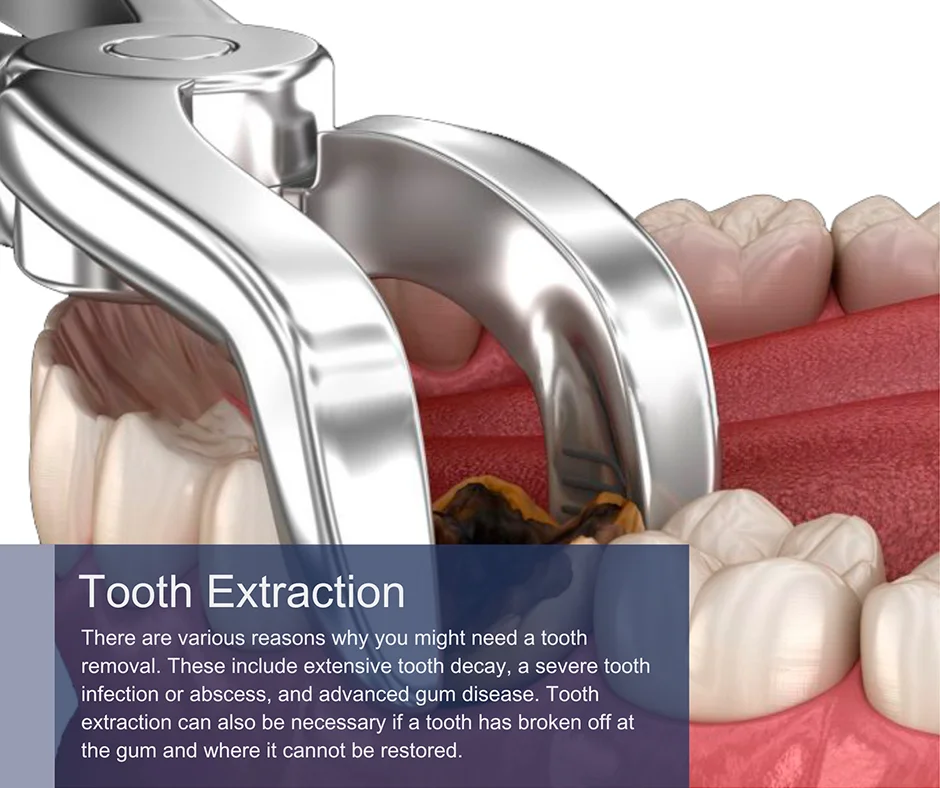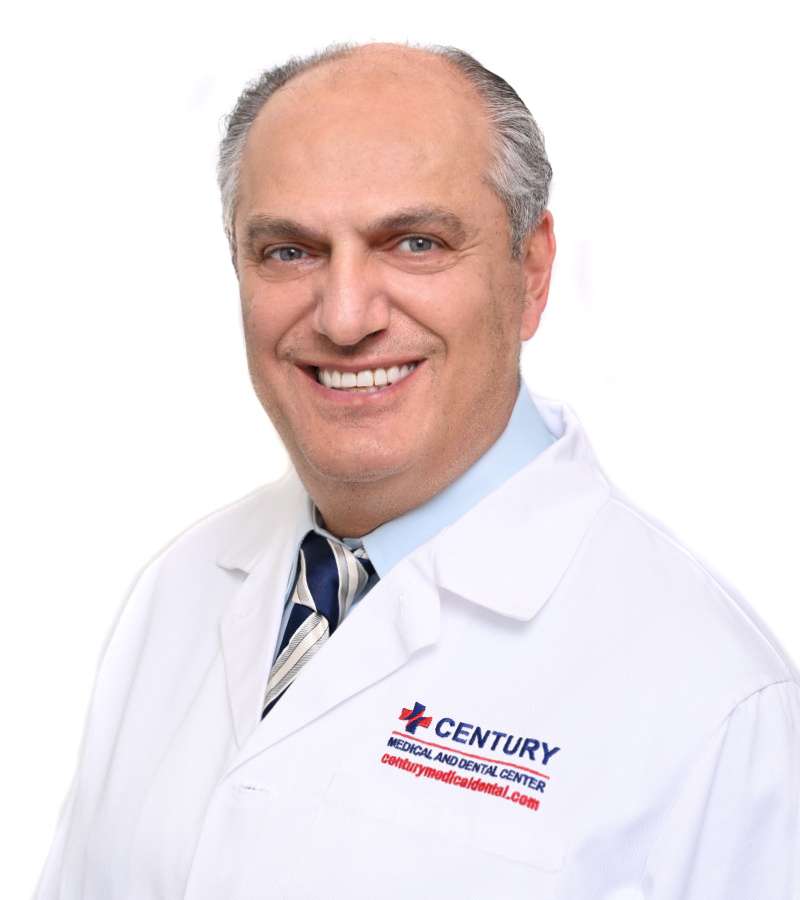Table of contents
As part of our general dentistry services, our dental team at Century Dental always strives hard to preserve natural teeth, and their removal is the last option, and we will only suggest this treatment when all other avenues have been exhausted. However, tooth extraction is sometimes inevitable. Except for wisdom teeth removal, missing teeth should always be replaced. Even losing a single tooth can cause dental problems such as shifting teeth, problems with your jaw joints, or with eating comfortably.
There are various reasons why you might need a tooth removal. These include extensive tooth decay, a severe tooth infection or abscess, and advanced gum disease. Tooth extraction can also be necessary if a tooth has broken off at the gum and where it cannot be restored. Sometimes a tooth can be severely fractured vertically through the tooth root and cannot be restored.
Wisdom teeth can become severely impacted, where they are stuck underneath the gum and cannot erupt or will partially erupt. A partially erupted wisdom tooth can become infected and decayed since the gum partly covering it will more easily trap food and plaque bacteria. If your wisdom teeth have yet to erupt, we can monitor them closely and will recommend their removal if it is clear they will not erupt problem-free.
If we think you need a tooth removed, we will carefully assess it, using digital dental x-rays to examine it closely and to detect any signs of damage or infection in the tooth root. These images also help us to plan its removal as they show the shape and number of tooth roots that must be extracted during the process.

A tooth extraction will not feel painful as we ensure the affected tooth and surrounding gum are numbed with local anesthesia. Once numb, special dental instruments are used to loosen the tooth from its bony socket. As the tooth is removed, you might feel a little pressure when it loosens from the surrounding bone, which is perfectly normal.
It might be necessary to make small incisions in the gum to remove a tooth that has broken below the gum line. Once the tooth is removed, the empty socket is cleaned, disinfected, and left to heal. Depending on your oral care needs, the socket might be left open, or we could choose to place some stitches.
Immediately after removing the tooth, a blood clot must form quickly in the empty socket to stop the bleeding and begin the healing process. We may ask you to bite down on a gauze pad for up to 30 or 45 minutes to stop the bleeding. If the empty socket is still bleeding after this time, we can replace the gauze bad and will ask you to bite down firmly again. Sometimes we must change the gauze pad several times to stop blood flow completely.
Wisdom teeth removal can be a slightly different process, especially if the wisdom teeth are impacted and stuck in the jawbone. In this case, we must make a small incision in the gum to see the bone covering the impacted tooth. Next, we make a tiny opening in the bone to expose the wisdom tooth. An impacted wisdom tooth is often cut or sectioned into several smaller pieces so that we can remove it through a smaller opening in the jawbone. Once all the wisdom tooth is removed, we can stitch the gum back in place, and the site is left to heal.
Bogdan Brajic is the best dentist I have ever been to! He’s very knowledgeable, professional and most importantly he cares about the patient!
Sometimes we will place a bone graft after tooth extraction while the empty socket is still open. Preforming a tooth extraction and bone graft during a single procedure can be useful when preparing the site for dental implants and is called bone socket preservation.
It is a technique that helps preserve the bony socket that originally supported the tooth and helps to ensure there is plenty of strong, healthy bone when we place the dental implant. We might also use this technique when replacing a tooth by other means, such as a tooth-supported dental bridge, as it will help protect the bony ridge underneath the gum and ultimately provide better aesthetics.
A straightforward tooth extraction is surprisingly quick and may take as little as half an hour to complete. If the extraction process is more complex, for example, if you have an impacted wisdom tooth or require bone grafting simultaneously, it will take longer, perhaps an hour or more.
When we assess your tooth, we can provide a more accurate estimate of the time needed for this appointment. Also, you must allow some time for the bleeding to stop afterward unless we stitch the gum shut.
Usually, most people will return to normal within a day or two after tooth extraction, but it can take longer for the jawbone to heal completely. Normal side-effects include swelling, bleeding, and some discomfort.
Ensuring you keep the extraction site thoroughly clean will help it heal more quickly and reduce the risk of any discomfort. You can use an antimicrobial mouthwash to gently rinse your mouth three times a day or use a saltwater rinse made by dissolving a teaspoon of salt in a cup of warm water.
It is important only to swish gently as rinsing your mouth too vigorously could dislodge the healing blood clot protecting the empty socket. It is better to avoid strenuous activity for a few days afterward, as an increased heart rate can increase the risk of post-operative bleeding. We can advise you when returning to everyday activities like exercising is safe.
Any pain after tooth extraction should be minimal. We will give you careful instructions on caring for the surgery site afterward, including advice about pain relief or a prescription for stronger painkillers if needed. Most people can relieve discomfort using over-the-counter pain relief like ibuprofen and acetaminophen. We may also prescribe antibiotics if there is a risk of infection afterward. Carefully following our instructions will help keep discomfort to a minimum and aid healing.
If you experience pain and swelling after a tooth extraction, use an ice pack or a pack of frozen peas or corn applied to the outside of your mouth. Any swelling should dissipate within a couple of days, but if you experience more severe pain, continued facial swelling a few days afterward, or severe bleeding, please contact Century Dental for immediate dental help and advice.

Family Dentist
Brooklyn
Gravesend

Family Dentist
Manhattan
Manhattan

Family Dentist
Brooklyn & Manhattan
Manhattan, Downtown

Dentist
Brooklyn & Manhattan
Gravesend, Manhattan, Downtown

Dentist
Manhattan
Manhattan

Dentist
Brooklyn & Manhattan
Manhattan, Livingston

Dentist
Brooklyn & Manhattan
Manhattan, Livingston
After having a tooth extracted, it’s best to avoid very hard or crunchy foods for the first few days afterward, and it’s also better not to eat anything like seeds or nuts as these could become stuck in the extraction site. Instead, stick to softer, easy-to-chew foods or foods that require no chewing, like eggs, rice, pasta dishes, applesauce, yogurt, and mashed potato. Avoid using a drinking straw as the sucking action could dislodge the blood clot. For this reason, you should also avoid smoking for the duration of healing and preferably try to quit for good.
Most people find tooth extraction straightforward, with minimal discomfort afterward. However, there is a small risk of a condition called dry socket. Dry socket can occur if the protective blood clot becomes dislodged, exposing the bone underneath and increasing the risk of the socket becoming infected. You will soon know if this happens because the empty socket will feel increasingly painful for a few days afterward.
Dry socket only occurs in a tiny percentage of cases, but if you are concerned or can see the exposed bone in the empty socket, contact us for help and advice. Our dentist can soon clean out the empty socket so the healing process can begin again.
Tooth extraction is a medical procedure that is covered by most insurance plans, but the specific coverage will vary depending on your plan. Call Century Dental Center to find out your specific coverage for tooth extraction.
If you have a failing tooth or a tooth that feels painful, please don’t delay but see us as soon as possible. We can assess the tooth to see if it can be saved. If it must be extracted, we can arrange a pain-free tooth extraction and discuss suitable ways to replace it afterward.
Century Medical and Dental Center is an accredited healthcare facility in NY that operates in accordance with Article 28, a public health law. This law regulates and recognizes accreditation for public healthcare facilities, ensuring they are licensed and operated correctly. By undergoing the Article 28 process and achieving accreditation, Century Medical and Dental Center demonstrates its commitment to meeting the highest standards of care.
As a multidisciplinary medical center, we have highly qualified doctors, nurses, and support staff who are working hard to provide the best medical care to patients in Midtown Manhattan, NY, Downtown Brooklyn, NY, including Brooklyn Heights, Dumbo, Prospect Heights, Park Slope, Clinton Hill, Boerum Hill, Red Hook, and Bedford-Stuyvesant.